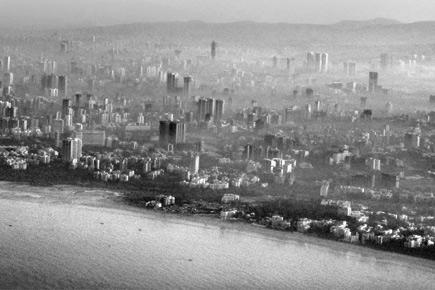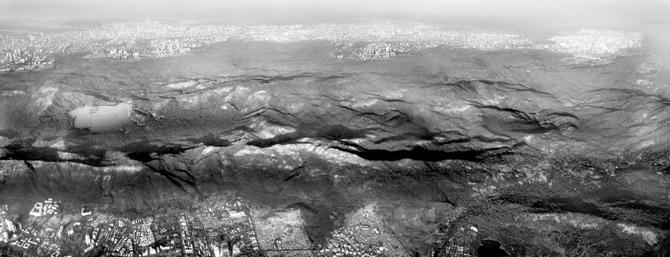Mumbai may have learned to live with its pollution, but British photographer Robert D Stephens struggles to find the city through his lens which returned on North Mumbai

Juhu Beach
For the past eight and a half years, Mumbai has been home to English architect and photographer Robert D Stephens. For him, the city is not just a place where he lives, but where he struggles — to breath, to see trees, even to find a patch of grass to walk on. “In that sense, Mumbai North is my attempt to identify and photograph some of the remaining ecological riches of the city — which have become so marginalised that they feel non-existent,” says the 31-year-old, who has photographed areas such as Powai, Gorai creek and Juhu from an airplane. “Also, from the air, Mumbai offered a compelling view that I felt must be captured,” he adds.
ADVERTISEMENT

Juhu Beach, January 2015. “Crescent-shaped and palm-fringed, Juhu is almost deserted on weekdays. Saturdays and Sundays, camels, ponies, acrobats and dancing monkeys enliven the scene.” — Bombay Handbook, Page 86, American Women's Association 1973
It was in 2009 that Stephens, the Principal at RMA Architects, first began shooting aerial images. The idea took birth while he sat at the window seat while flying over Mumbai. Last year, he exhibited his work that captured South Mumbai, covering areas like Tardeo, Apollo Bunder, Lower Parel and Dadar. His new project Mumbai North, spans from December 2014 to November this year. “The only difference between now and then is that the hi-rises of South Mumbai are slightly higher, and more in number. The smog still wraps around the towers like romance makers huddled together on Marine Drive — stuck with nowhere else to go.”

Sanjay Gandhi National Park, December 2014: “The sublime natural landscape provides a handsome bait for escape from urban rigidity; especially the lake areas with their wild landscape, the ornamental patches of well laid-out gardens set against a back-ground of more rugged growth of trees, overlooking the serene waters of the lake has a magnetic attraction.” — Development Plan for Greater Bombay, Page 52
A large chunk of his research was done through Google Earth and reading of archival material on the city. While all the images were taken from an airplane, Stephens won’t tell us how he got access to it, apart from the fact that there’s no permission needed to shoot such pictures. “This is the only secret I prefer to keep,” he says.
The inspiration for Mumbai North came from the overwhelming scale of Sanjay Gandhi National Park. “From the air, one realises just how large SGNP is — nearly 17 per cent of Mumbai's land mass — equivalent to 1,91,800 local train compartments,” he says. Armed with a hand-held Sony camera that fits in his pocket, Stephens found that the smothering air pollution was the biggest obstacle in his way. “On many days, I’d be above the city and not able to see the city!” Air pollution, he adds, is something we Mumbaikars have learned to live with. “Four years ago, I went to my doctor and explained that I had a recurring scratchy thoat. I asked if he could prescribe something to help. His response was, ‘Congratulations, you are a Bombay resident now’,” he laughs.

Gorai Creek, January 2015. The surveys carried out have revealed that the city has roughly about ¼ acre / 1,000 population as against 7 acres and 10 acres / 1,000 population standard adopted in Britain and the U.S.A. There being no effective measures to prevent overcrowding and to check the prevailing high densities consequent upon the low living standards these have all summed up to make the existing open spaces more and more deficient. — Development Plan for Greater Bombay, Page 50, Municipal Corporation of Greater Bombay, 1964
Interestingly, all the 24 photos are captioned with historical excerpts from a host of books about Mumbai, from the The Charm of Bombay edited by RP Karkaria in 1915 to a 1980 book titled Fertility and Family Planning in Greater Bombay by JR Rele and Tara Kanitkar. However, Stephens’ favourite photograph is one of Aldeamear Fort that shows the Western boundary of suburban Mumbai, with an artistic folding line where land and sea meet. The supporting archival text is paired with an excerpt from a book published in 1953, titled Roads to Beauty Around Bombay written by Homi J H Taleyarkhan.
Stephens prefers to keep the pictures black and white. “It is the city of contrasts. But, also the city of grey spaces, where black and white cooperate to make beautiful compositions together,” he smiles.
 Subscribe today by clicking the link and stay updated with the latest news!" Click here!
Subscribe today by clicking the link and stay updated with the latest news!" Click here!








